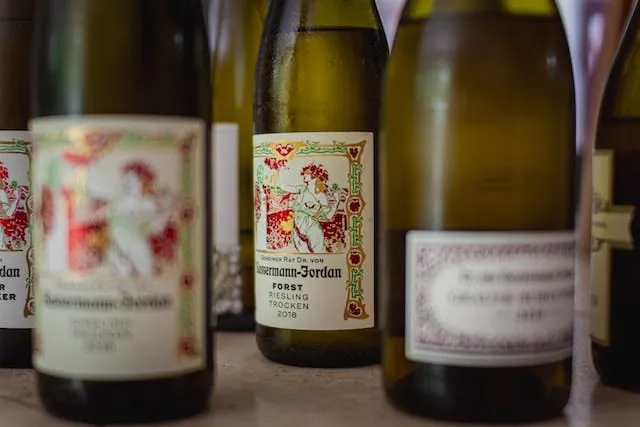- Wine Color/Type
- Top Occasions
- Unique Wines
- Surprise Me!
Riesling — The Versatile Champion
Riesling stands as one of the most diverse grape varieties in the world. Its high acidity and finesse provide winemakers with a wide range of styles, from light-bodied bone dry Mosel to luscious TBA, from world-class sparkling to ice wines of Germany and Canada.
Trocken style Riesling (Credit: Photo by Sandra Grünewald , Unsplash.com)
Thriving in Cool Climates
Riesling thrives in cool climates, and its diverse character has led to its cultivation beyond its German origins. It can be found in regions like New York State in the US, Canada, Austria, Alsace in France, and Clare Valley in Australia, each producing a unique style with its own signature. These regions offer cool temperatures that help preserve the wine’s freshness and acidity. In Alsace, the long growing season allows winemakers to harvest grapes late, resulting in more full-bodied dry styles, lighter sweet late harvest (Vendange Tardive) wines, and more luscious Sélection de Grains Nobles. Additionally, some prefer early picking to create world-class sparkling wines that rival the quality of Champagne or English sparkling wine. While Winzersekt, a German sparkling wine, is rarely exported, it holds great potential for its outstanding quality.
The Classics
A traditional Riesling is typically a light-bodied, bright, acidic wine with a long, fruit-driven mineral finish. Occasionally, a touch of residual sugar balances the acidity perfectly, adding complexity and structure to the wine. Its light to moderate alcohol content makes it an ideal summer wine, complementing Asian dishes with its light sweetness and acidity.
The Lightest Wines
The bright acidity and fruity flavors of lemon, lime, yellow apple, and pineapple can be retained and enhanced in lighter Riesling-styled wines, commonly known as Kabinett in Germany. These wines often display an alcohol content of 9–11.5 percent abv, and the slight residual sugar balances the tart acidity, creating what Germans call an acid-sugar interplay. Additionally, Riesling can be found with lower alcohol levels in the dry segment of wine. Wine lovers should look for the words “dry” or “trocken” to ensure they select the correct wines. If a wine contains the term “feinherb,” it means it has some residual sugar but tastes dry as the acidity balances the sweetness.
Full-Bodied Superstars
The versatile Riesling variety also offers full-bodied late-harvested wines, commonly found in Germany, Alsace, or the Austrian premium appellation, Wachau. Their signature is a dry, full-bodied voluptuous wine, which acidity contributes to freshness, driving minerality over the palate. Some Spätlese wines may be sweet, due to the absence of the term “trocken” (dry) on the label, so caution is advised. The best selections can be found in the form of Erstes Gewächs, Grosse Lage (GG-Symbol on the bottle), Smaragd, or single-vineyard Alsacian Grand Cru labels.
The Sparkling Elegance
Sparkling Riesling can undergo a second fermentation in the bottle or receive its bubbles through fermentation in the tank. Regardless of the method, the fruitiness and bright acidity always shine through. When bottle fermented, the wines are typically matured for at least 2 years on the lees, which leads to a fine texture, with longer maturation adding extra layers of brioche and cookie dough notes. The high acidity contributes to a long life in the cellar, continuously improving over time.
The Sweet Tooth
For some winemakers, the grapes are left on the vines until late autumn, being affected by the noble rot, botrytis cinerea. This process adds an additional layer of honey and waxy flavors, concentrating the sugar content, creating a more intense taste. Wine lovers can seek out Beerenauslesen (BA) or Trockenbeerenauslesen (TBA) to experience these delicious drops.
Legendary Ice Wines
Ice wines rank among the best wines in the world. Sought after for centuries, these wines impress wine lovers of all levels, from beginners to seasoned connoisseurs. Harvested in freezing cold temperatures, often at night, Riesling grapes are crushed and slowly fermented. The low alcohol levels, combined with the vibrant acidity, offer a unique style. Their harvest conditions have become rarer due to climate change, making it a unique speciality which may not be produced every year. Unlike their sweet BA and TBA counterparts, the grapes used in ice wines were not affected by the noble rot, enhancing their fruity character.
Riesling’s diverse range of styles caters to every wine lover, making it an accessible and perfect choice for every occasion. Its global popularity and adaptability have garnered widespread appeal, ensuring that wine enthusiasts from all walks of life can enjoy its delightful offerings.
by Peter Douglas
Latest articles

